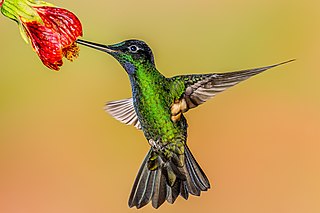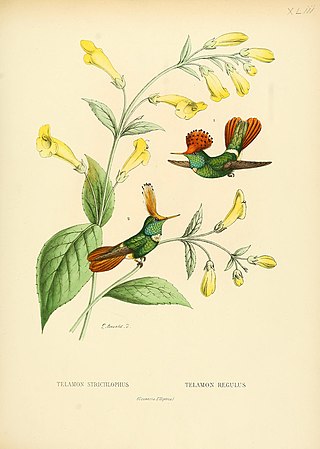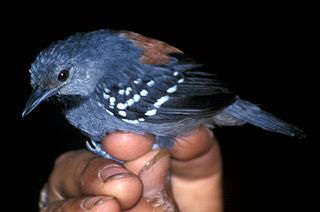
The magenta-throated woodstar is a species of hummingbird in tribe Mellisugini of subfamily Trochilinae, the "bee hummingbirds". It is found in Costa Rica and Panama.

The bronze-tailed plumeleteer is a species of hummingbird in the "emeralds", tribe Trochilini of subfamily Trochilinae. It is found in Colombia, Costa Rica, Ecuador, Nicaragua, and Panama.

The blue-vented hummingbird is a species of hummingbird in the "emeralds", tribe Trochilini of subfamily Trochilinae. It is found in Costa Rica and Nicaragua.

The purple-throated woodstar is a species of hummingbird in tribe Mellisugini of subfamily Trochilinae, the "bee hummingbirds". It is found in Colombia, Ecuador, and Panama.

The chestnut-bellied hummingbird is a Near Threatened species of hummingbird in the "emeralds", tribe Trochilini of subfamily Trochilinae. It is endemic to Colombia.

The snowy-bellied hummingbird, also known as snowy-breasted hummingbird, is a species of hummingbird in the "emeralds", tribe Trochilini of subfamily Trochilinae. It is found in mostly in Costa Rica and Panama with a few records in Colombia.

The golden-bellied starfrontlet is a species of hummingbird in the "brilliants", tribe Heliantheini in subfamily Lesbiinae. It is endemic to Colombia.

The buff-winged starfrontlet is a species of hummingbird in the "brilliants", tribe Heliantheini in subfamily Lesbiinae. It is found in Colombia, Ecuador, and Peru.

The violet-capped hummingbird is a Near Threatened species of hummingbird in the "emeralds", tribe Trochilini of subfamily Trochilinae. It is found in Panama and far northwestern Colombia.

The greenish puffleg is a species of hummingbird in the "brilliants", tribe Heliantheini in subfamily Lesbiinae. It is found in Colombia, Ecuador, Panama, and Peru.

Humboldt's sapphire or Humboldt's hummingbird is a species of hummingbird in the "emeralds", tribe Trochilini of subfamily Trochilinae. It is found in Colombia, Ecuador, and Panama.

The sapphire-bellied hummingbird is an Endangered species of hummingbird in the "emeralds", tribe Trochilini of subfamily Trochilinae. It is endemic to Colombia.

The spangled coquette, coquette pailletée (French), coqueta coronada, or coqueta lentejuelada is a species of hummingbird in the "coquettes", tribe Lesbiini of subfamily Lesbiinae. It is found in Brazil, Colombia, Ecuador, Peru, and Venezuela.

The Tacarcuna wood quail is a species of bird in the family Odontophoridae, the New World quail. It is found in Colombia and Panama.

The chestnut-headed crake is a species of bird in subfamily Rallinae of family Rallidae, the rails, gallinules, and coots. It is found in Bolivia, Brazil, Colombia, Ecuador, and Peru.

The ornate stipplethroat, formerly called the ornate antwren, is a species of bird in subfamily Thamnophilinae of family Thamnophilidae, the "typical antbirds". It is found in Bolivia, Brazil, Colombia, Ecuador, and Peru.

The lineated foliage-gleaner is a species of bird in the Furnariinae subfamily of the ovenbird family Furnariidae. It is found in Colombia, Costa Rica, Ecuador, Panama, Peru, and Venezuela.

The spotted woodcreeper is a species of bird in the subfamily Dendrocolaptinae of the ovenbird family Furnariidae. It is found in Belize, Colombia, Costa Rica, Ecuador, El Salvador, Guatemala, Honduras, Mexico, Nicaragua, and Panama.

The lettered aracari or lettered araçari is a near-passerine bird in the toucan family Ramphastidae. It is found in Bolivia, Brazil, Colombia, Ecuador, and Peru.

The cinnamon-sided hummingbird is a species of hummingbird in the "emeralds", tribe Trochilini of subfamily Trochilinae. It is endemic to the Mexican state of Oaxaca.






















